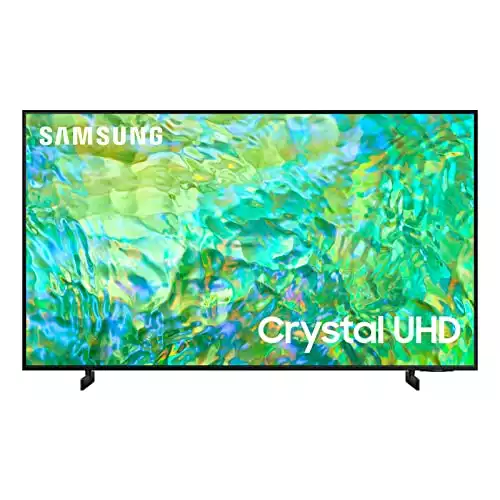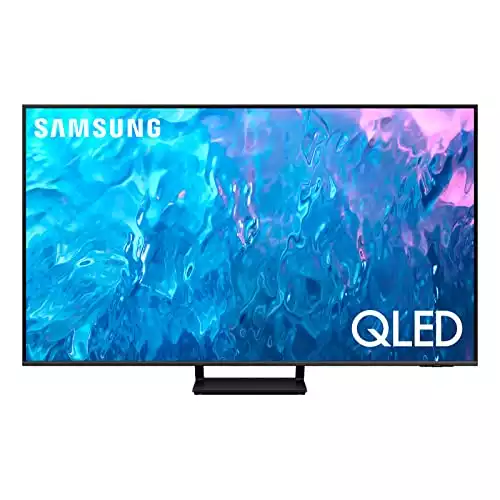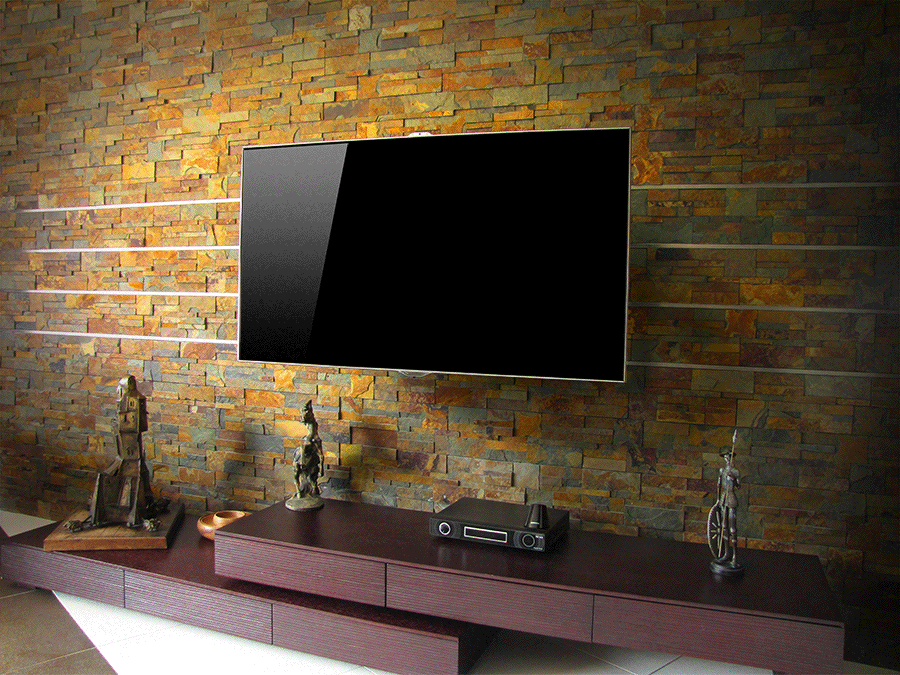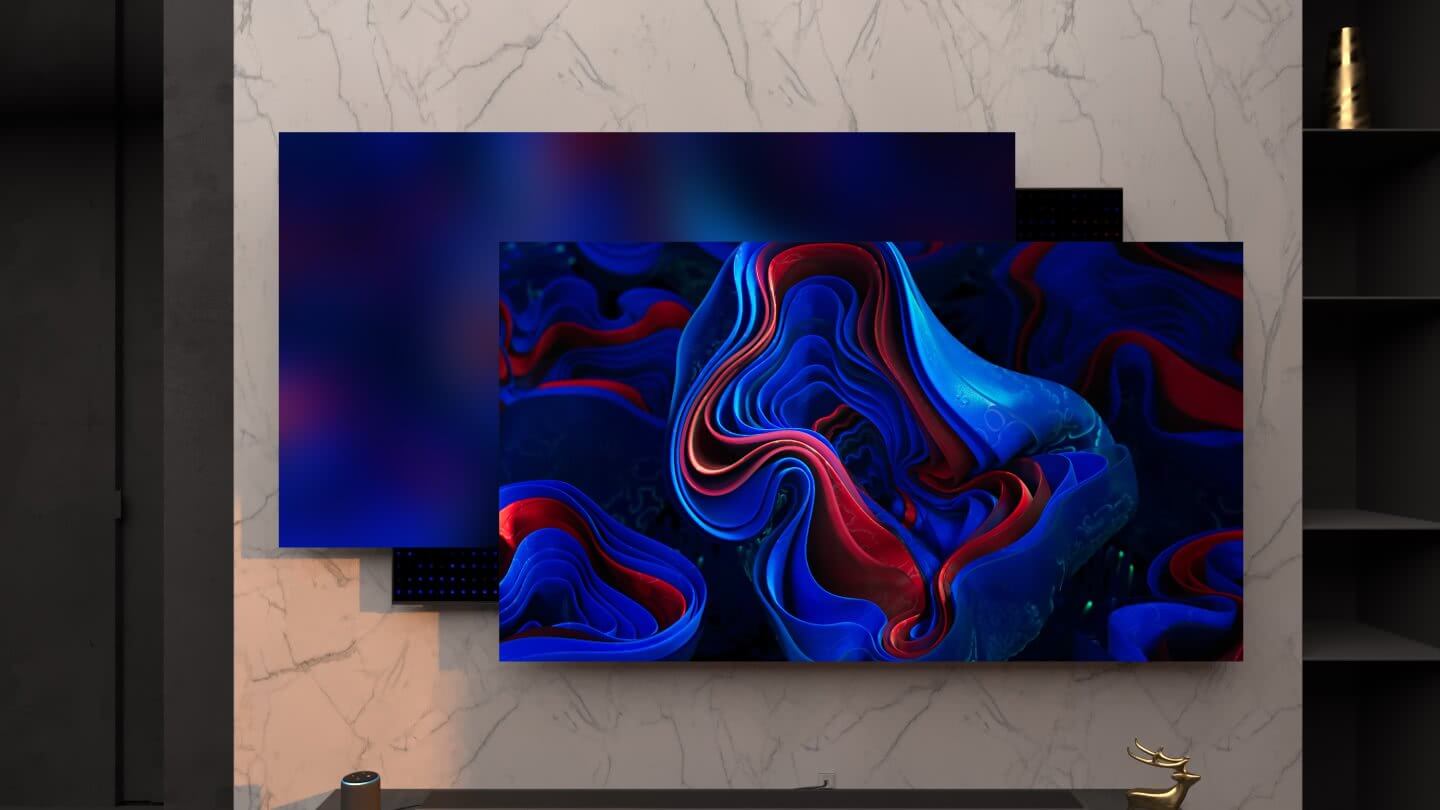
Is it time to upgrade your TV? Shopping for a new TV can be daunting. Technology and terminology can be very confusing.
We compiled this helpful guide to get you up to speed on QLED vs UHD TV technology.
If you’re researching TVs to buy, you’ve probably come across two industry terms – QLED and UHD. QLED is a category name for TVs that use quantum dot technology. UHD is also known as 4K.
What do these mean, and what’s the difference?
First, it is essential to understand that there’s no “one or the other” or “one is better than the other” here. QLED and UHD describe entirely different technologies.

What Is UHD?
First, let’s start with UHD, which stands for “Ultra High Definition“. This refers to the TV having a 4K display resolution (four times the pixel density of full HD).
It has a better dynamic range, leading to more detailing and better color handling than conventional HD. Some UHD TVs are available with an astounding 8K resolution.
UHD is not a “new” type of TV technology like QLED, but rather an improvement on the “full HD” 1080p LCD (liquid-crystal display) TVs
. With more and more 4K content becoming available, UHD is a feature you’ll want for your next TV.
A UHD TV operates like a QLED TV in that it has an LED backlight and LCD screen, but it lacks the QLED TV’s quantum dots to improve color and brightness.
The most important thing to remember is that UHD is not technically a type of TV but a description of its 4K resolution. What’s confusing is that although UHD and 4K are not the same technology, the terms are often used interchangeably.

What Is QLED?
Next, let’s dive into QLED, a category name for TVs that use quantum dot technology to create or enhance color. QLED stands for “Quantum Light-Emitting Diode.” The word “quantum” refers to using tiny particles called quantum dots. Quantum dots are tiny particles. Quantum dots emit red and green light when blue light shines through them.
The light from the LED panel travels through a quantum dot screen before reaching the liquid-crystal display (LCD) at the front of the QLED TV. This produces the recognizable images we watch.
The Differences, In a Nutshell
To summarize, these are the biggest differences between QLED and UHD TVs:
- QLED technology uses an LED backlight to hit a screen of quantum dot particles that supercharge the TV’s pixels for brightness and color beyond the standard quality of other LCD TVs.
- UHD TVs are higher-resolution versions of the standard LCD TV. Both OLED and QLED TVs usually offer UHD resolution!

How does QLED (Quantum Dot Technology) work?
All QLED TVs have a quantum dot filter. It’s a film of tiny crystal semiconductor particles that replace old TVs’ red, green, and blue color filters. Quantum dot filters can precisely control their color output.
However, there are differences in quantum dot implementation. Quantum dot offers a step-up color performance, but not all quantum dots are created equal.
Various levels of quantum dot implementations available in the industry provide different levels of color performance. Color is measured using what’s called the rec2020 color space. The more color space coverage, the better. Color space is the standard Dolby Vision, and other HDR formats are used. It is the most expansive color space currently available for electronic displays.
You’ll find the ‘QLED’ label on a few TV brands, including TCL and Hisense, but generally, it refers to a Samsung TV. Recently, Vizio has entered the QLED TV market, utilizing Samsung’s quantum dot technology.
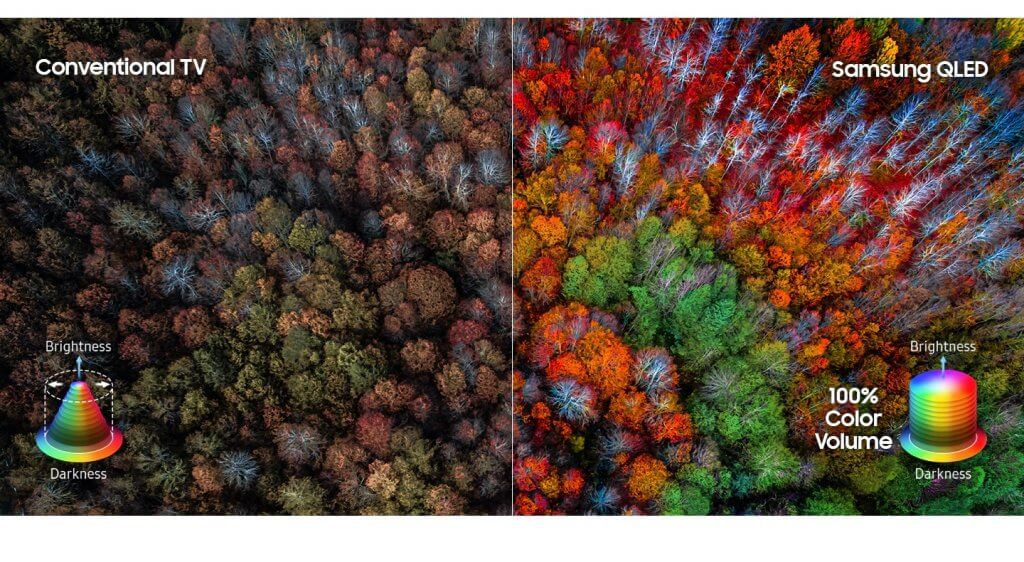
QLED TV vs UHD TV: Side-by-Side Comparison
| Feature Comparison | QLED TV | UHD TV |
| Vibrant Colors | ✔️ | |
| Clarity | ✔️ | |
| Brightness | ✔️ | |
| Response Time | ✔️ | |
| Energy Efficient | ✔️ | ✔️ |
| Pricing | ✔️ | |
| Overall | ✔️ |
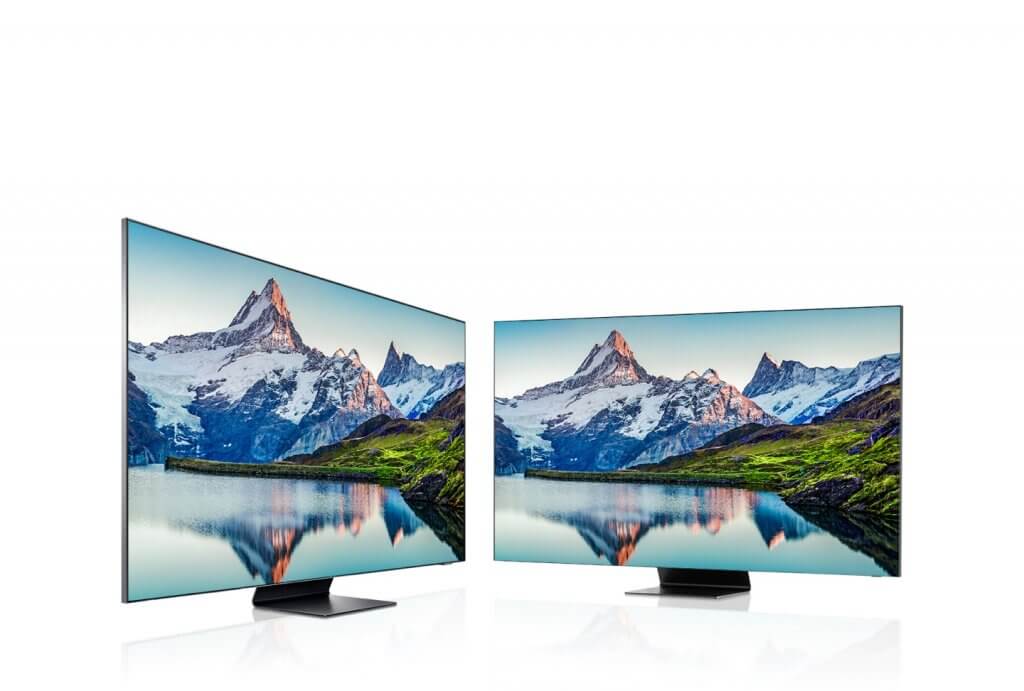
Samsung QLED TVs
In 2024, the TV landscape offers varied choices beyond just QLED. While Samsung remains a significant player, brands like LG and Sony present compelling alternatives like OLED and Mini LED.
For budget-conscious buyers, 4K QLED TVs from Samsung or brands like TCL offer excellent value and picture quality. Newer models like Samsung’s 2024 Q70A and Q80A series boast improved brightness, color accuracy, and upscaling capabilities compared to earlier models.
If you’re willing to invest in the future, 8K QLED options like Samsung’s Neo QLED TVs deliver stunning detail and cutting-edge features like Mini LED backlighting and advanced HDR. However, remember that 8K content is still limited, so consider your viewing habits before leaping.
For outdoor enthusiasts, Samsung’s The Terrace offers a weatherproof QLED experience perfect for patios or decks. However, be mindful of potential glare issues and a higher price tag than regular QLED TVs.
Ultimately, the best TV depends on your individual needs and budget. Carefully consider your viewing habits, features you prioritize, and research options before purchasing.

Unveiling VIZIO’s Quantum Color
VIZIO’s Quantum Color TVs have become synonymous with vibrant pictures and cutting-edge tech. But with multiple series under the Quantum banner, choosing the right one can feel like navigating a color wheel yourself.
This guide will break down VIZIO’s Quantum Color 2024 lineup, helping you find the perfect TV to suit your budget and viewing needs.
M-Series Quantum: Your Gateway to Quantum Brilliance
Think of the M-Series as the friendly neighborhood Quantum Color entry point. Starting at budget-friendly sizes (43 inches!), these models pack a punch with up to 80% wider color gamut than your average UHD TV.
That translates to richer, more lifelike hues, and with 600 nits of peak brightness, even dimly lit scenes pop with detail. And to ensure deep blacks and stunning contrast, VIZIO throws in up to 90 local dimming zones, like the tiny heroes of the picture world.
P-Series Quantum: Where Performance Takes Center Stage
Ready to graduate to advanced viewing? The P-Series Quantum is your Quantum Color champion. Imagine Dolby Vision HDR unlocking previously unseen detail in shadows and highlights while a color gamut covering up to 90% of the Rec.2020 standard paints your screen with a kaleidoscope of vivid colors. But the party doesn’t stop there.
P-Series Quantum cranks the brightness up to a jaw-dropping 3000 nits, meaning even sunlit scenes retain dazzling clarity. With up to 480 local dimming zones, say goodbye to washed-out blacks and hello to stunning contrast that immerses every scene.
V-Series Quantum: The New Kid on the Block
Are you looking for a sweet spot between M-Series value and P-Series power? Enter the V-Series Quantum, the newest member of the VIZIO Quantum family. It strikes a perfect balance with Dolby Vision HDR, a color gamut spanning up to 85% of Rec.2020, and peak brightness reaching 300 nits. Think of it as your gateway to premium picture quality without breaking the bank.
Choosing Your Quantum Champion:
With all this Quantum goodness, picking the perfect TV can be a delightful dilemma. Here’s a quick cheat sheet:
- M-Series: Budget-friendly entry point with stunning color and brightness.
- P-Series: Premium performance with Dolby Vision HDR, wider color gamut, and exceptional brightness.
- V-Series: The happy medium between M-Series affordability and P-Series power.
Remember: Screen size matters! VIZIO’s Quantum Color lineup offers a range of options, from cozy 43-inch displays to expansive 75-inch beauties. So, grab your measuring tape and dream big!
No matter which VIZIO Quantum Color TV you choose, one thing’s for sure: your viewing experience is about to get a serious upgrade.
Exploring QLED in the Wider TV Landscape
While Samsung and Vizio are often at the forefront of QLED discussions, several other brands deserve attention for their unique takes on this vibrant technology. Let’s dive into some notable players making waves in the QLED scene:
Hisense
Hailing from China, Hisense has carved a niche with its ULED technology, which incorporates quantum dots into its own unique backlight solution. Hisense ULED TVs boast impressive brightness, often exceeding Samsung’s QLED offerings, making them ideal for well-lit rooms or HDR content. Additionally, their 8K ULED models are a tempting option for future-proof gaming setups, thanks to their high resolution and competitive price tags.
TCL
A rising star in the TV market, TCL is known for delivering excellent value for money. Their QLED lineup comes in various series, each catering to different budgets and needs. The 5-Series is a budget-friendly option with decent picture quality, while the 6-Series steps it up with higher brightness, better contrast, and more premium features. And for those seeking an extra punch, the QM8 series delivers top-notch performance with Mini LED backlighting and advanced gaming features.
Sony
Sony, a giant in the electronics world, doesn’t ignore QLED entirely. While their Bravia XR OLEDs take center stage, they offer a few QLED models like the X95L Mini LED. This high-end TV merges Quantum Dot technology with Mini LED backlighting, resulting in exceptional brightness, contrast, and HDR performance. However, be prepared for a premium price tag that reflects its cutting-edge features.
LG
While primarily known for their industry-leading OLED TVs, LG also dabbles in QLED with their QNED series. These models combine Quantum Dot technology with LG’s NanoCell technology, aiming to improve color accuracy and viewing angles. QNED TVs can be a good option for those seeking an alternative to OLED who value wider viewing angles and potentially lower price points.
Skyworth
Emerging from China, Skyworth is a brand to watch, especially for budget-conscious buyers. Their QLED TVs offer decent picture quality at attractive prices, making them a solid choice for casual viewers. While they may not compete with high-end offerings from other brands, they provide a good entry point into the QLED world without breaking the bank.
Remember, choosing the right QLED TV goes beyond brand alone. Consider factors like screen size, resolution, HDR support, gaming features, and smart TV platform to find the perfect fit for your needs and budget.
Explore the offerings from these and other QLED manufacturers, compare features, and read reviews to discover the hidden gems waiting to elevate your home viewing experience.
Should I buy a QLED TV?
With advancements in QLED technology, high-end TVs now offer exceptional picture quality at more accessible prices. Deciding to purchase a QLED TV largely depends on your budget. Premium QLED models, especially those with top-tier features, can still be a significant investment.
In 2024, the pinnacle of QLED TVs includes models with 8K resolution. While 8K is unnecessary for every viewer, its benefits are most noticeable on larger screens, such as those over 75 inches. If you’re considering a TV of this size, opting for 8K could enhance your viewing experience.
Quantum Leap in TV Technology
The 2024 QLED TV lineup boasts sleek designs, advanced features, and cutting-edge technology. Choose from elegant 4K models or top-tier 8K displays, each offering stunning visuals with quantum dot technology at competitive prices.
For superior picture quality, QLED TVs are an ideal choice. Currently, 4K Ultra HD TVs strike the perfect balance between advanced technology and affordability, making them a prime option for those seeking high-quality displays without stretching their budget.
To make one your own, learn which time of year is the best time to buy a TV.
QLED vs UHD TV: Quantum Dot FAQ
What is QLED?
A TV panel technology that uses quantum dot technology to create or enhance the color of TV screens.
Which is better, QLED or UHD?
One is not better than the other. UHD is not technically a type of TV but a description of its 4K resolution. UHD and QLED describe entirely different technologies.
Is QLED better than 4K?
QLED TV will be better in terms of color accuracy, leading to a great viewing experience.
What is the difference between QLED and premium UHD?
The main difference between QLED and Premium UHD is that the QLED is powered by Quantum dot TV display technology while the Premium UHD is a standard used in 4K range TV displays. Premium UHD established a consensus for 4K Ultra HD specifications. They focus on the clarity and sharpness of the picture quality to create realistic images.
Are QLED TVs expensive?
Some certainly are, but some mid-range models won’t break your budget.
Is QLED worth the extra money?
It’s a step up from regular Ultra HDTVs. QLED panels have made for some incredible high-end televisions with stunning bright screens and strong upscaling ability. Some are now offered at mid-range prices.

